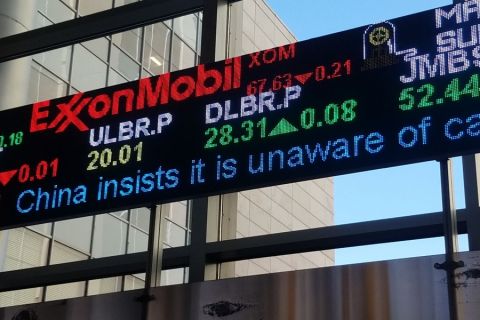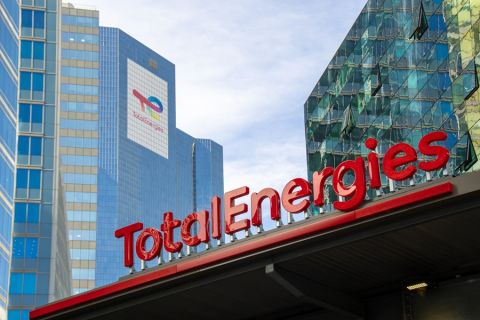Backward whirl can impact well economics, reducing drilling efficiency and rate of penetration (ROP), increasing non-productive time (NPT), and damaging downhole tools.
Backward whirl occurs when the drillstring switches from being in sliding contact to rolling contact with the borehole. Once a drillstring assembly goes into rolling contact with the borehole, it rotates backwards around the center point, essentially climbing the hole. The drill-string then starts to process backwards, creating traction on the borehole, and continues to rotate at a high frequency, depending on the clearance between the drill-string and the borehole. Eventually, it rotates clockwise on its axis while traveling counter-clockwise around the inside of the hole. If left unchecked, backward whirl can be stopped only by shutting down the drilling operation.
Although backward whirl can occur in all well environments, it is more likely at lower inclinations (vertical drilling) and is estimated to randomly occur to some degree in 40% of all wells. As the inclination increases and the drilling trajectory becomes more horizontal, the likelihood of backward whirl decreases, but it can still occur.
Friction and high speed
Friction between the contact points of the drillstring – drill bit, bit cutters, stabilizers, or collars – and the borehole is crucial. As friction between the contact points and the hole increases, backward whirl becomes more likely. Furthermore, sharp edges on the drillstring can bite into the rock, creating traction that can lead to backward whirl.

A full-scale backward whirl simulation rig provides the ability to study whirl in a research setting. (Images courtesy of Weather-ford International)
Backward whirl can reach frequencies anywhere from 5 to 30 times the speed of the drillstring. This speed makes the force especially violent, creating a combination of high fatigue-loading and strong impact-loading conditions that can cause significant vibration and irreparable damage to downhole tools.
A technology designed to detect backward whirl in real time has been developed to combat this phenomenon, which has serious ramifications if not controlled early in its self-perpetuating cycle.
Weatherford International Ltd.'s Real-Time Whirl Detector is proving to be a valuable tool in controlling backward whirl, which is occurring more frequently with the increasing use of rotary drilling. It is of particular concern with rotary steerable systems (RSS), which require the drilling mechanism to rotate continuously while drilling. The tool was designed to operate with the company's Revolution rotary steerable system.
The technology uses existing sensors on the rotary or RSS mechanism itself to provide a real-time warning that backward whirl is beginning to occur. With early intervention, the engineer and rig crew can take immedi- ate action to adjust drilling parameters in the bit weight or RPM to reduce the effects.
Lab and field testing
The theory was tested in a a well in Oklahoma created for field testing. Engineers observed that during a whirl event, friction on the drillstring increased. Therefore, the required drive torque also increased, creating more and more energy going into the wellbore, which fueled the backward whirl. When torque on the drive system builds up at the surface, the drillstring winds up, stops for several seconds, breaks free, and then accelerates at a very high speed before spinning out. Backward whirl is believed to occur during the spin-out phase.
The system was deployed in six wells in three geographic regions from July 2008 to April 2009.
The detection system works by transmitting a real-time warning to the surface from the downhole sensor, having calculated a number indicating the severity of the backward whirl event so appropriate action can be taken. There are three levels of backward whirl – low, moderate, and high. Once the backward whirl action reaches the severe level, drilling must be stopped and evasive action taken immediately. If the event is moderate, less extreme measures can be taken, such as adjusting the drilling parameters to shift the event back into the low range. The objective is to reduce the whirl motion such that drilling does not have to stop.

RSS deployment using real-time whirl severity updates.
Successful deployment
The system has had a marked impact in drilling optimization in a variety of well environments. In Central Europe, a motorized Revolution RSS assembly had been deployed in horizontal gas wells for a period of time. But on one well, operators using the detection system began receiving high backward whirl readings with real-time warnings that action was needed. In checking the BHA, they discovered the stabilizers were undergauge for what essentially was a poor-quality, overgauge hole, which created increased clearance between the borehole and the stabilizers. The deviation from stable drilling created the increased whirl intensity.
Using the downhole data, engineers made the decision to install new stabilizers on the BHA, which resulted in the operator achieving the maximum ROP for that particular environment while maintaining stable drilling. When the BHA was examined following drilling operations, it was apparent that the equipment had sustained significantly more damage during periods of high backward whirl than incurred during runs where backward whirl was low. Subsequently, similar BHA stabilization measures were taken in other wells where increasing whirl intensity was detected following stabilizer wear.
The system also was used successfully in a North Sea well to maximize ROP. Prior to deployment of the system, the drilling parameters had been adjusted to provide more weight on the bit and increase RPM. These adjustments created adverse drilling dynamics, compromising directional performance and tool reliability. The whirl detector allowed the operator to apply a set of drilling parameters that achieved balanced drilling performance and component reliability. With balance restored, drilling ahead continued at the maximum ROP possible for the drilling conditions. Ongoing updates of whirl severity were communicated to the surface at a frequency of one per minute.
Since mid-2010, Weatherford has deployed the backward whirl detection system in hundreds of operations, including all Revolution RSS assemblies worldwide. The system has actively prevented downhole tool failures, increased average ROP, and reduced NPT. The technology is undergoing further refinement as engineers continue to develop knowledge to better understand the interaction between whirl and other types of downhole dynamics.
Recommended Reading
BP Restructures, Reduces Executive Team to 10
2024-04-18 - BP said the organizational changes will reduce duplication and reporting line complexity.
ProPetro to Provide eFrac Services to Exxon’s Permian Operations
2024-04-29 - ProPetro has entered a three-year agreement to provide electric hydraulic fracturing services for Exxon Mobil’s operations in the Permian Basin.
TotalEnergies Eyes Suriname FID by Year-end 2024
2024-04-29 - France’s TotalEnergies and U.S. partner APA Corp. look to place their long lead orders ahead of a final investment decision related to their joint development offshore Suriname in Block 58.
Kimmeridge Fast Forwards on SilverBow with Takeover Bid
2024-03-13 - Investment firm Kimmeridge Energy Management, which first asked for additional SilverBow Resources board seats, has followed up with a buyout offer. A deal would make a nearly 1 Bcfe/d Eagle Ford pureplay.
M4E Lithium Closes Funding for Brazilian Lithium Exploration
2024-03-15 - M4E’s financing package includes an equity investment, a royalty purchase and an option for a strategic offtake agreement.





